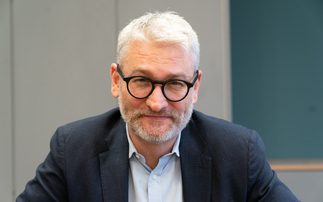
The panellists were (left to right): WTW credit manager researcher Hanna Wan, Pi Pension Trustees trustee director Graham Jung, HSBC Asset Management head of UK consultants Tom Cella, HSBC Asset Management head of UK corporate pension sales Jasvir Virk, HSBC Asset Management securitised investment team head of trading and portfolio management Andrew Jackson, Trafalgar House director Lyn Ellis, XPS Pensions Group head of manager research Faye Clark, Professional Pensions editor Jonathan Stapleton (chair) and Independent trustee Gary Hughes
In June, Professional Pensions assembled a panel of experts to discuss opportunities for pension funds in securitised credit.
The roundtable - chaired by PP editor Jonathan Stapleton and held in association with HSBC Asset Management - looked at the role securitised credit could play in pension scheme portfolios, particularly in the post-LDI crisis environment.
In particular, it discussed how pension scheme usage of these assets is evolving, looked at which areas of the market for these assets are showing opportunities, and evaluated the risks involved in the assets and how they can be minimised by managers.
Andrew, could you begin by giving us an overview of securitised credit please?
Andrew Jackson: In its simplest form, securitised credit is about turning mortgages or loans into securities that can be traded. Our funds tend to fit between fixed income bonds and private credit - and we aim to capture most of the liquidity of bonds and some of the features of loans.
‘Why now?' is a key question in investment decisions. In securitised credit, it comes down to income as the funds generate so much of it. Income comes in two elements. Firstly, the base rate element, as it is a floating rate asset class. Base rates are of course going up everywhere in the world. The other element is credit spreads. Investors understand this asset class contains complexity and liquidity risks.
Our house view of where rates are going is that they will remain elevated for a significant period of time. Even if they start to come down at the end of 2023, which is now looking less likely, or 2024, they are still going to remain elevated for a long time. This is ‘baked in' already. The other thing is that when constructing a well-rounded portfolio, many investors add this asset class because it moves independently of equities and fixed income and so it is a very good diversifier.
For many years, collateralised loan obligations (CLOs) have been the obvious place to invest. However, today, commercial mortgages are the best place to play in the high-quality space.
Our broad view of the market is that there are a lot of threats around. We are very conservatively positioned, which is the right approach to take, and subtle in terms of where we allocate. We do not invest in middle market or small and medium-sized enterprise (SME) loans, and we do not invest in commercial real estate CLOs. We believe it is better to stick to the high-quality institutional end, both in the US and Europe.
We are very light in the consumer sector everywhere around the world. At the prime end it does not pay enough, so there is no value there. At the subprime end there are two issues. Firstly, such subprime loans often fail the social part of our ESG analysis. Secondly, in the likely coming recession, it is going to be the less advantaged in society that are going to struggle and these are the people that have these sorts of loans, so we are likely to see a difficult situation arise.
Overall, we deliver a lot of income and think that will continue for the foreseeable future. We believe, in the round, we are well protected.
What has been your experience of investors' perceptions of securitised credit?
Graham Jung: I have certainly found that investors view it as a separate asset class, but also as part of multi-asset credit portfolios.
The first question for defined benefit (DB) schemes when making investment decisions is: ‘What do I need to sell in order to buy it?' I can no longer just leverage my liability-driven investment (LDI) holdings to buy securitised credit, so what do I have at the moment that no longer fits the overall portfolio?
Tom Cella: I have always liked the asset class of securitised credit. The asset class has a nice yield premium over vanilla credit, but it is not as risky as many perceive. In terms of assets to sell, it could replace a portion of traditional fixed income, even though rates are quite attractive at the moment. You could diversify your core fixed income allocation with an allocation to this, to get some benefits and a more diversified portfolio.

In terms of how it can fit into LDI, one of the key points is liquidity. This is obviously a necessity when you are using assets within a collateral waterfall structure. We have had no bad experiences in the past when moving assets around and that is the basis of our ‘proof statement'. Providers need a demonstrative history of satisfying redemptions as they come. From that perspective, we think it fits very nicely into a waterfall - while it also optimises on the return side.
Lyn Ellis: The return comes from long-term investments in mortgages, which are illiquid. The problem is that, by definition, you need to also invest in things that are not mortgages just to maintain liquidity. You need to balance those two requirements. If all your clients asked for their money back on the same day, even if they are invested in AAA, they could not all have it.
Andrew Jackson: We were involved in all the different markets when we went through last September and October. Typically, turnover - traded volume - is around about $5bn (£3.9bn) a day, so there is a lot of flow. 29 September was the largest trading day by volume in European history, but it worked. One of our pension funds wanted to liquidate on the day. It took a little bit of pain, but we were able to liquidate.
Graham Jung: Who are the other investors in the fund?
Andrew Jackson: During the LDI crisis, we had very limited outflows compared to some of our competitors. A lot of corporate treasurers get involved in our investment grade fund because they look at it as cash plus. It is AA-rated and they get paid cash, which now pays a lot more at above 2%.

On the asset side we run all our portfolios in a very diversified way. We try to diversify away risk by market, by sector and by individual bonds.
Hanna, how are your clients approaching this?
Hanna Wan: There has been more interest in securitised credit. Historically the asset class perhaps was less understood, it is a market that is quite complex, and therefore require specialist managers with the right expertise. But it does offer greater diversification in clients' credit portfolio, providing exposure to assets that are harder to come by with conventional debt instruments. The process of securitisation also creates new assets that can meet different needs of clients with varying risk appetites. The market is quite opaque though so can become quite illiquid during periods of economic stress, so we are cautious on the liquidity. Though the senior tranches are generally fairly liquid.
Gary, what has been your experience with securitised credit? Are any of your schemes either looking at it or already invested?
Gary Hughes: Exposures are limited. Obviously, going back a year or so ago, it was short duration credit, so we are now looking at what is available to reposition. Specifically, is there country bias? Is it majority US or in US mortgages?
Andrew Jackson: No, we have not got any traditional residential mortgages in the US. Formally, we try to maintain global market weights.
I would like to explore the perceived and actual complexity of securitised credit and whether that is perhaps a concern for trustees.
Lyn Ellis: One thing that concerns me is who chooses the underlying properties against which the loans are secured. How experienced is that person?
Andrew Jackson: Our track record is good. What typically happens is we have a sponsor who gets involved in lending to a borrower secured on a property and then they put that together in a prospectus. We then get to see X number of prospectuses and choose the ones we want.
We have confidence in our process. We have the experience and have had no defaults.
Jasvir Virk: This is a really important point. Obviously, Andrew is not picking the stock himself, but the results are a testament to the strength of the research by the broader team, the investment process and due diligence goals.
Gary Hughes: Is there any currency risk if you are global?
Andrew Jackson: The short answer is we hedge it all out. The accounting currency for all our funds is US dollars. We offer sterling hedged, euro hedged, Japanese yen hedged, if you want, as well as accumulating and distributing share classes.
Faye, how do you ensure, in such a complex area, that the managers are indeed good enough?
Faye Clark: We have been spending more time on this recently, which is reflective of the conversations we have had here in terms of more client demand. We want to see evidence that liquidity could be met during the crisis last year and also to understand how regulation has impacted the investable universe for European investors. Another area that we have been focused on in our research is ESG, or sustainability. There are different layers to due diligence, for example managers need to look at the different underlying collateral pools and issuers.

Hanna, how do you look at and assess managers in this area?
Hanna Wan: It's similar to how we look at the other asset classes within our manager research process. It is not just performance, but the sustainability of that performance that is also quite important so we also look at how the team works together, and the culture within the team and wider firm. Approach to sustainability is something we look at closely, how this is being integrated within the investment process, and the framework around that.
What sustainability considerations are there with securitised credit? How do you manage them and integrate them into your portfolio construction?
Andrew Jackson: The team is rated A+ by the Principles for Responsible Investing (PRI), the top rating. When our credit analysts examine a transaction, they look at the credit side and then complete an ESG template that assesses everything. There are E, S and G considerations and these are different for each asset class, so each credit analyst will have a different weighting among those to produce an overall ESG score.
As I mentioned earlier for subprime debt, for example subprime credit cards and autos, our process almost exclusively fails the S part of our ESG assessment because we think the interest rate is inappropriate. For CMBS, E is more relevant because of how the underlying building has been put together got to be the right kind of building, environmentally, and government regulations are always very important. All our funds are Sustainable Finance Disclosure Regulation (SFDR) 8, so they need to meet a high bar.
Hanna Wan: You say that, for RMBS, for example, you can get that EPC data and then for CMBS there is probably something equivalent. Where you stand today, how much of that is based on estimates and when do you think you will get actual emission data at a mandate level?
Andrew Jackson: Today, we are putting the process in place. If we get actual data, we will put it through the engine, and it will be fine. There will be quite a lot of estimation, but we are leaving it open so that when the data becomes available it is an automatic conversion into a proper carbon intensity score.
This roundtable was held on 22 June 2023 in association with HSBC Asset Management.






